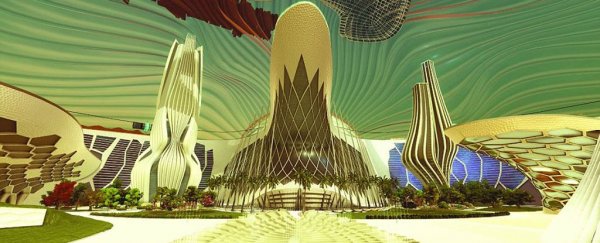NASA and SpaceX aren't the only players in the Mars colonisation game, with the United Arab Emirates (UAE) having just outlined an ambitious plan of its own: to build a city the size of Chicago on the Red Planet.
While US interests are intent on shipping us to Mars within the next two decades, the UAE is taking a decidedly more long-term view, with its "Mars 2117" project set to design, build, and populate a human colony on Mars over the course of the next 100 years.
Announcing the plan at the World Government Summit in Dubai on Tuesday, UAE vice president and ruler of Dubai, Sheikh Mohammed bin Rashid Al Maktoum, described Mars 2117 as an ongoing UAE effort to develop scientific knowledge until Mars colonisation is possible, with the help of international partners.
"The new project is a seed that we plant today, and we expect future generations to reap the benefits, driven by its passion to learn to unveil a new knowledge," said Sheikh Mohammed.
"The landing of people on other planets has been a longtime dream for humans. Our aim is that the UAE will spearhead international efforts to make this dream a reality."
The project, to be named "Mars 2117", integrates a vision to create a mini-city and community on Mars involving international cooperation. pic.twitter.com/v27jA3K3pS
— HH Sheikh Mohammed (@HHShkMohd) February 14, 2017
While hard details on the initiative are thin on the ground right now, it's a serious plan, following the UAE's existing commitment to launch its 'Hope' space probe in 2020, to orbit and study the Red Planet until at least 2023.
Obviously, Mars 2117 is a much more ambitious project, and while the primary focus of the plan for now is to invest in and develop science education infrastructure in the UAE, those behind the plan have also unveiled their vision of what their Mars colony might one day look like.
"The city is roughly the size of Chicago. It has a population of 600,000," the manager of the scientific and research committee at the World Government Summit, Saeed Al Gergawi, told CNBC.
"We came up with that number because it's like someone going to an exotic island. Not everyone can go first, then we get advancement of rocket tech, which makes people move there easily, then the advancement of oxygen tech to make it more Earth-like, which would incentivise people."
The "Mars 2117" project will develop an Emirati and international team of scientists to push the human exploration of Mars in years to come. pic.twitter.com/5ujxvyC8As
— HH Sheikh Mohammed (@HHShkMohd) February 14, 2017
While Mars 2117 still has a lot of fine details to figure out – they have a century to work on it, after all – the long-term delivery of the UAE plan may actually be a heck of a lot more realistic than other dreams we've been sold of getting to the Red Planet.
Elon Musk made a lot of headlines when he teased his own pitch for Mars exploration last year, suggesting that SpaceX's Interplanetary Transport System (ITS) could begin flights to the Red Planet as soon as 2023.
But while we love Musk's vision, critics say SpaceX doesn't have the funds to deliver.
"It's unlikely that [Musk] will be able to get humans on Mars by 2025," former director of the Space Policy Institute at George Washington University John Logsdon told the AFP in September.
"Bottom line is the cost. You're talking of tens of billions of dollars, and SpaceX doesn't have that type of money."
We aspire in the coming century to develop science, technology and our youth's passion for knowledge. This project is driven by that vision. pic.twitter.com/4QibJjtiM2
— HH Sheikh Mohammed (@HHShkMohd) February 14, 2017
Another high-profile Mars venture called Mars One has said it will get colonists to the Red Planet by 2032. But many have argued that the organisation lacks the funding, manpower, and expertise to pull off the feat.
So if private companies can't afford the level of investment that an ongoing Mars colonisation might entail, the best bet might still be governmental space agencies.
For its part, NASA says that its next-generation rocket – the Space Launch System (SLS) – has what it takes to get humans to Mars, but the mission has been hamstrung by funding issues since first announced in 2004.
Hopefully, that could all be about to change, with then-President Obama in October 2016 pledging that NASA would reach Mars by the 2030s – a prospect that could be even more likely now, given NASA is looking into accelerating the process of getting astronauts into space on board the SLS.
That could be our best bet of getting boots on the ground on the Red Planet in the near term, but as for a long-lasting colony? Mars 2117 just might be it.
